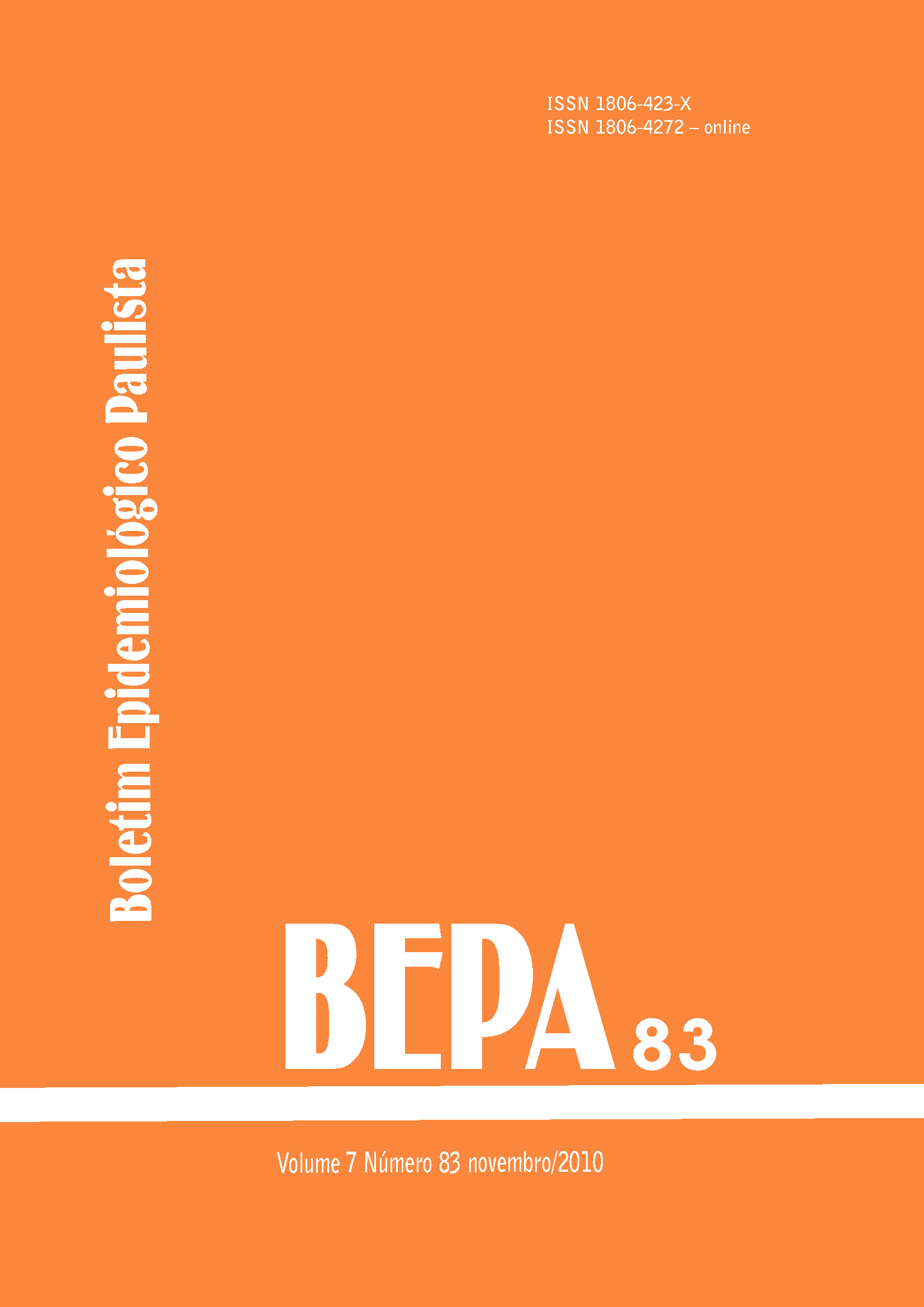Abstract
The promotion of exclusive breastfeeding is the isolated intervention that most prevents infant death. This paper presents trajectory the implantation of Breastfeeding and the Municipalities Project (Amamunic) in municipalities in the state of São Paulo in the period 1998 to 2008 and analyze the patterns of exclusive breastfeeding. Data were analyzed in SPSS 16.0. We analyzed the involvement of municipalities in the state and the percentage of participation in each of the 17 Regional Health Departments (DRS). Parameters of WHO (2003) were used to classify the occurrence of exclusive breastfeeding in children under 6 months of age. The evolution of exclusive breastfeeding in the counties that participated more than once was analyzed considering the first and last surveys of each municipality and the time interval between them. From 645 municipalities of São Paulo, 345 participated in the survey (53%) of these, 170 participated one time and 175 participated two or more times. The participation of municipalities was heterogeneous among DRS, ranging from 20% to 100%. According to WHO parameter, 1998 had the highest prevalence (61.9%) of municipalities classified in situation "bad", with an improvement of this profile over the years. The strategy of conducting surveys of infant feeding on vaccination campaigns has proved viable in the state of Sao Paulo and enables to check the favorable trend in exclusive breastfeeding.
References
Jones G, Steketee RW, Black RE, Bhutta ZA, Morris SS. Bellagio child survival study group. How many child deaths can we prevent this year? Lancet. 2003;362:65-71.
Victora C, Barros FC. A questão da sobrevivência infantil no mundo e sua relevância para as Américas. Cadernod ESP – Escola de Saúde Pública do Ceará. 2005;1(1).
Escuder MML, Venancio SI, Pereira JC. Estimativa do impacto da amamentação sobre a mortalidade infantil. Rev Saúde Pública. 2003;37(3):319-25.
Martins Filho J. O aleitamento materno no contexto socioeconomicocultural. Aleitamento materno: perspectivas atuais. In: Issler H, coordenador geral. O aleitamento materno no contexto atual: políticas, práticas e bases científicas. São Paulo: Sarvier; 2008. p. 31.
Newcomb PA, Storer BE, Longnecker MP, Mittendorf R, Greenberg ER, Clapp RW, et al. Lactation and a reduced risk of premenopausal breast cancer. N Engl J Med. 1994;330:81-7.
Ramos CV, Almeida JAG. Alegações maternas para o desmame: estudo qualitativo. J Pediatr. 2003;79(5):385-90.
Araújo MFM, Fiaco AD, Pimentel LS, Schmitz BAS. Custo e economia da prática para o aleitamento materno para a família. Rev Brás Saúde Matern Infant. 2004;4:135-41.
World Health Organization.Infant and young child nutrition.WHA RESOLUTION 54.2, Geneva, 2001.[Acesso em 17 de jun 2010]. Disponpivel em : http://www.reich-schottky.de/ pdf_kodex/wha_res_54_2de.pdf.
Venancio SI, Monteiro CA. A evolução da prática da amamentação nas décadas de 70 e 80. Rev Bras Epidemiologia. 1998;1(1):40-9.
Monteiro CA. O panorama da nutrição infantil nos anos 90. Cadernos de Políticas Sociais, Unicef, Série Documentos para Discussão, 1. Brasília: Unicef; 1997.
Sociedade Civil Bem-Estar Familiar no Brasil. Pesquisa Nacional sobre Demografia e Saúde. Rio de Janeiro: Bemfam; 1997. p. 125-38.
Brasil. Ministério da Saúde. Pesquisa Nacional de Demografia e Saúde da Criança e da Mulher – PNDS 2006. Brasília: Ministério da Saúde; 2009. p. 195-212.
Brasil. Ministério da Saúde. Secretaria de Atenção à Saúde. II Pesquisa de Prevalência de Aleitamento Materno nas Capitais Brasileiras e distrito Federal. Brasília, 2009.
Carvalhaes MABL, Parada CMGL, Manoel CM, Venâncio SI. Diagnóstico da situação do aleitamento materno em área urbana do Sudeste do Brasil: utilização de metodologia simplificada. Rev Saúde Pública. 1998;32(5).
Kitoko PM, Réa MF, Venancio SI, Vasconcelos ACCP, Santos EKA, Monteiro CA. Situação do aleitamento materno em duas capitais brasileiras: uma análise comparada. Cad Saúde Pública. 2000;16(4).
World Health Organization. Indicators for assessing infant and young child feeding practices: conclusions of a consensus meeting held 6–8 November 2007. Washington, DC, 2008.
Instituto Brasileiro de Geografia e Estatística – IBGE [banco de dados na internet]. Unidades da federação [acesso em 17 mar 2010]. Disponível em: http://www.ibge.gov.br.
Secretaria da Saúde [base de dados na internet]. Regionais de Saúde. Estado de São Paulo segundo Departamentos de Saúde, 2007 [acesso em 17 mar 2010]. Disponível em: http://www.saude.sp.gov.br/content/ geral_estrutura_regionais_de_saude.mmp.
World Health Organization. Infant and young child feeding: a tool for assessing national practices, policies and programmes. Geneva; 2003.
Santos LMP, Paes-Sousa R, Silva Junior JB, Victora CG. National Immunization Day: a strategy to monitor health and nutrition indicators. Bulletin of the World Health Organization. 2008; 86:474-479.
Castro IRR, Engstron EM, Cardoso LO, Damião JJ, Rito RVFV, Gomes MASM. Tendência temporal da amamentação na cidade do Rio de Janeiro: 1996-2006. Rev Saúde Pública [acesso em 7 jun 2010]. 2009;43(6):1021-9. Disponível em: http://www.scielo.br/ scielo.php?script=sci_arttext&pid=S0034 -89102009000600014&lng=en&nrm=iso.
Brasil. Ministério da Saúde. Secretaria de Atenção à Saúde. Departamento de Ações Programáticas e Estratégicas. II Pesquisa de prevalência de aleitamento materno nas capitais brasileiras e Distrito Federal. Brasília; 2009.
Parizoto GM, Parada CM, Venâncio SI, Carvalhaes MA. Trends and patterns of exclusive breastfeeding for under-6-month-old children. J Pediatr. 2009;85(3):201-8.
Silva SM, Brunken GS, França GVA, Escuder MM, Venâncio SI. Evolução do aleitamento materno em uma capital da Região Centro-Oeste do Brasil entre 1999 e 2004. Cad Saúde Pública. 2007;23(7):1539-46.
Rea MF. Reflexões sobre a amamentação no Brasil: de como passamos a 10 meses de duração. Cad Saúde Pública. 2003;19(Sup. 1):S37-S45.
Secretaria de Estado da Saúde [São Paulo]. Plano Estadual de Saúde 2008-2011. São Paulo; 2008. p.79.

This work is licensed under a Creative Commons Attribution 4.0 International License.
Copyright (c) 2010 Sonia Isoyama Venâncio Isoyama Venâncio, Silvia Regina Dias Médici Saldiva, Ana Lucia da Silva Castro, Ana Gabriela Cepeda Gouveia, Andréia Cardoso de Santana, Juliana Cristina Correa Pinto, Maria Mercedes Loureiro Escuder
